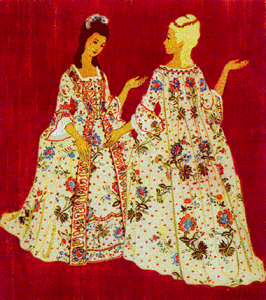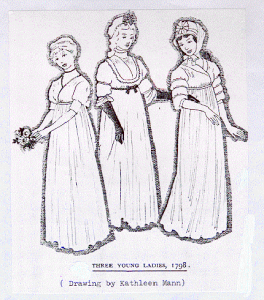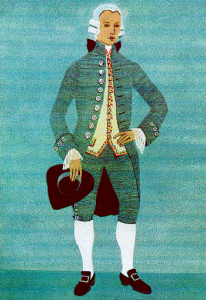Fashion in Scotland
Ladies’ Fashion

- Two ladies wearing sack-back dresses, c. 1760.
- Stuart Maxwell and Robin Hutchison, Scottish Costume 1550-1850 (London: Adam and Charles Black, 1958) 88.
[click on the picture to enlarge it]
As regards fashion, Paris and London had always set the tone. Before 1770, Scottish upper-class ladies used to wear crinoline dresses which sometimes could be as much as nine feet wide thanks to several layers of starched petticoats supported by rush hoops. The precious fabrics of these dresses (silk, satin, brocade, velvet or lace) were imported from England, France, Italy, the Netherlands and even from China. They were so costly that the wealthiest and most beautiful ladies were obliged to wear the same dress several years running and to alter its shape from time to time in order to follow the whims of London and Paris fashion.
When the textile industry developed in Scotland in the second half of the eighteenth century and new materials such as linen and silk gauze, cotton and silk muslin appeared on the market, there was no longer a need to buy abroad. Fashion lost its stiffness and became more graceful, more fluid and more libertine. The extravagantly wide dress with panniers which gave the wearer a rigid appearance disappeared and was replaced by a light printed muslin gown which accentuated the shape of the body. The English traveller Edward Topham remarked upon the grace and elegance of these upper-class ladies: “The ladies in Edinburgh dress, in general, with more elegance, and in a way better accommodated to their persons, size, and shape, than most of the European nations. . . . They choose the most becoming fashions from London and Paris, and form one of their own, more graceful, perhaps, than either.” [Letters from Edinburgh Written in the Years 1774, 1775 (London, 1776) 198-99. ]

- Three young Ladies, 1798
- (drawing by Kathleen Mann)
Stuart Maxwell and Robin Hutchison, Scottish Costume 1550-1850 (London: Adam and Charles Black, 1958) 88.
[click on the picture to enlarge it]
At the end of the eighteenth century, all classes of society in Scotland longed to look their best and the attire of women of modest social standing differed little from that of upper-class ladies, as Thomas Somerville noted in his Memoirs: “Now [1800], even servants are hardly distinguishable in their equipment from their mistresses.” [My Own Life and Times 1741-1814 (Edinburgh, 1861) 377.] The simpler cut of clothes and the low price of cotton fabrics enabled Scottish ladies to dress elegantly and to possess a wardrobe of a pretty cotton dress, a silk cloak and a stylish hat.
Gentlemen’s Fashion

- Gentleman, c. 1780
- Stuart Maxwell and Robin Hutchison, Scottish Costume 1550-1850 (London: Adam and Charles Black, 1958) 88.
[click on the picture to enlarge it]
Whereas the ladies of the upper middle classes and the aristocracy distinguished themselves by their grace and elegance, gentlemen on the contrary didn’t seem to care very much about their appearance according to the traveller Edward Topham: “The Gentlemen neither know how, nor are studious of setting off their figure to advantage. In the politest assemblies in this City, you rarely see a Gentleman well-dressed.” [Letters from Edinburgh Written in the Years 1774, 1775 (London, 1776) 199.] The cut of their dress which made people think they had “the worst taylors, perhaps in the world,” (203) according to Topham, consisted of a tail-coat, waistcoat and breeches. This male attire underwent only slight changes during the eighteenth century.
In 1790, the tails of the coat came higher on the hips, the waistcoat only covered the chest instead of reaching to the knee and the stockings were made of cotton or silk instead of wool. Lace cuffs and a silk waistcoat with embroidered edges were the only extravagance in this somewhat severe dress. Leather shoes set off with a buckle and a cane with a silver or gold knob completed the outfit. The wig, much valued before 1770, was worn less and less by gentlemen in the last decade of the eighteenth century.

